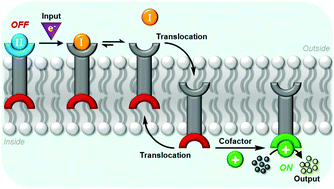Redox switching of an artificial transmembrane signal transduction system†
Abstract
Transmission of chemical signals across lipid bilayer membranes can be achieved using membrane-anchored molecules, where molecular motion across the bilayer is controlled by switching the polarity of two different head groups. An external redox signal delivered by ascorbic acid was used to trigger membrane translocation in a synthetic transduction system.



 Please wait while we load your content...
Please wait while we load your content...